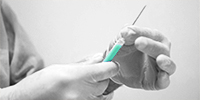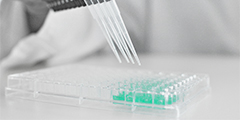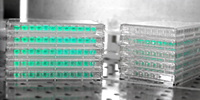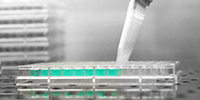We use cookies to make your experience better. To comply with the new e-Privacy directive, we need to ask for your consent to set the cookies. Learn more.
Once the immunogen and host species have been selected and validated, the development itself of the antibody can start. The immunogen is injected into the host animal(s) according to our well-established immunisation protocols and the antiserum is collected periodically for testing to follow the evolution of the immunoreactivity.
Immunisation protocols
All host species do not trigger the same immune response to a given immunogen. According to their respective physiology, some animals can exhibit a high immune response within less than two months while other require almost three to show the same result. Thanks to our strong experience, all protocols have been optimised and their efficiency proven.
Learn more about immunisation.
ELISA monitoring
During the immunisation protocol, it is important to follow the evolution of the animal immunoreactivity in order to make the right decisions when the immune response is not as high as expected. By modifying some characteristics of the immunisation protocol, the immune response can be greatly improved, ensuring the success of the project.
Learn more about ELISA monitoring.
At this stage, polyclonal antibodies are available and ready-to-use or can be purified and / or labelled. On the other hand, monoclonal counterparts require further development to generate, identify and isolate immortalised antibody-producing cells called hybridomas.
Fusion of splenocytes with myeloma cells
Instead of only collecting the antiserum of the immunised animal, we also proceed to the chirurgical extraction of its antibody-producing splenocytes. These still mortal cells are then fused with an immortalised cell line to generate hybridomas, and cultured under selection pressure.
Learn more about fusion.
Screening of positive hybridomas
Only hybridomas can survive within the selection medium, but not all of them are of interest, for some can come for example from endogenous spleen cells. Using the previously developed ELISA procedure, the wells of the cell culture plate that contain antibody-producing hybridomas are identified and selected for the next step of development.
Learn more about screening.
Cloning of selected hybridomas
At this step, hybridomas are still polyclonal. Each cell is then isolated from each other to allow them to grow separately. Using the ELISA procedure, only the ones that produce the expected antibody in high quantities are retained.
Learn more about cloning.





